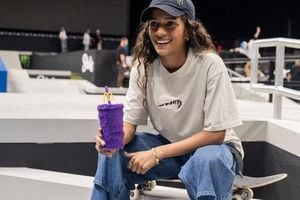RuPaul's Drag Race has evolved significantly since it first aired, shifting from what many deemed trans-exclusionary to becoming one of the cornerstones of trans visibility within mainstream entertainment. With each season, the show has not only entertained millions but has also sparked important conversations about gender identity and representation.
When Carmen Carrera, one of the first drag queens to openly discuss her identity transformation, appeared on season three of Drag Race back in 2011, she did so without fully realizing the impact her presence would have on the show’s future. At the time, the atmosphere within the Drag Race ecosystem was marked by casual transphobia and exclusionary practices, often leaving trans contestants at the mercy of not only the judges but also the audience’s narrow perceptions of gender and identity.
Looking back, one can't overlook RuPaul's operational catchphrases, some of which, like 'You've got She-Mail!' and songs featuring terms such as “tr*nny” and “lady boy,” are now considered offensive and reflective of the problematic framework under which Drag Race initially operated. For competitors like Carrera, the gap between their reality and the show’s acceptance process was evident. She stated, "I began my transition literally the day after filming,” underlining her exploration of identity post-show. This discrepancy exposed the flaws within the Drag Race model, which failed to fully support its trans contestants.
By the time Carmen publicly voiced her concerns about the negative jargon used on the show, feelings had shifted both among fans and within the drag community. Her 2014 Facebook post brought attention to some of the language restrictions present on the show, emphasizing the need for more thoughtful consideration toward the terms being used. "We live in a new world where acceptance is on the rise,” Carrera insisted, pushing Drag Race to adapt its approach toward visibility.
Following seasons saw growing representation of trans people, but much of it was characterized by the notion of 'tolerance.' Jiggly Caliente and Honey Mahogany were notable figures, as they represented some of the first trans voices articulately striving for their identities to be acknowledged within the competition. Yet, Drag Race demonstrated a pattern of allowing inclusivity up until it threatened to overshadow the primary narrative, which was often centered around cisgender contestants.
Monica Beverly Hillz shattered boundaries within season five by being the first contestant to officially come out as trans during her run; she poignantly remarked, "Drag is what I do, trans is who I am.” This moment was significant, yet she was eliminated shortly thereafter, casting doubts on the show's intent behind the visibility offered to trans individuals. Such incidents highlighted systemic challenges within the Drag Race universe, which at times seemed to pit traditional drag artistry against the broader demand for trans representation.
The turning point for trans attitudes came during season nine when Peppermint entered the competition as the first openly trans contestant. Although still early in her transition, Peppermint’s presence prompted RuPaul himself to issue controversial remarks about the eligibility of trans women based on their medical transitions. His comments were met with sharp backlash from both contestants and fans alike. Initially dismissing Peppermint's experiences, RuPaul later recognized the error of his words and posted on Twitter apologizing to the trans community, reaffirming their integral role within the LGBTQ+ movement.
Fast forward to seasons ten through thirteen, marking the rise of more heavily accepted trans personalities such as Gottmik, who became the first openly trans man to compete. Gigi Goode and others were revealed to be trans post-show, continuing the pattern of delayed acceptance associated with their lives outside the competition. This scenario indicates the structural impediments still present on the show during those seasons; contestants were often more comfortable discussing their transitions once their time on-screen had finished.
The narrative drastically changed upon entering the current seasons, where there are finally prominent and celebrated builds toward supporting trans queens both on and off the track. Recent seasons have made strides not just to fill quotas but to embrace and celebrate the realities of transgender individuals. Promoting these narratives candidly allows the experience of being trans—and the unique challenges and triumphs associated with it—to shine through.
One recent Drag Race queen, Lala Ri, competed on season 13 and won the coveted title of Miss Congeniality. Recently, she announced her intention to step away from performing as her drag persona, stressing, "I’m leaving the drag behind, but trust me, The LaLa Ri Experience is still very much alive.” This booming shift emphasizes the fluidity not only present within the drag world but also reflects the contestants' broader desire to explore and redefine their identities beyond the confines of drag.
Drag queens like RuPaul have been influential as trailblazers, but the importance of visibility for trans women and men cannot be understated. The show still faces criticism, especially concerning how it handles sensitive topics around race, representation, and gender, as its history continues to reveal lessons about inclusivity and evolution.
Today, RuPaul’s Drag Race is not just entertaining reality TV; it is at the forefront of important conversations about gender identity, the transition process, and the intersections of race and sexuality. The growth and development of the show over the years demonstrate the potential for media to evolve and embrace the vibrant diversity of the LGBTQ+ community.
Peering back at the cutting-edge presence of the show offers fans hope for what’s to come. The show's future can only be envisioned stronger than its past—an ultimate assertion of empowerment, visibility, and transformation through art and performance, stretching far beyond the boundaries of the runway.



